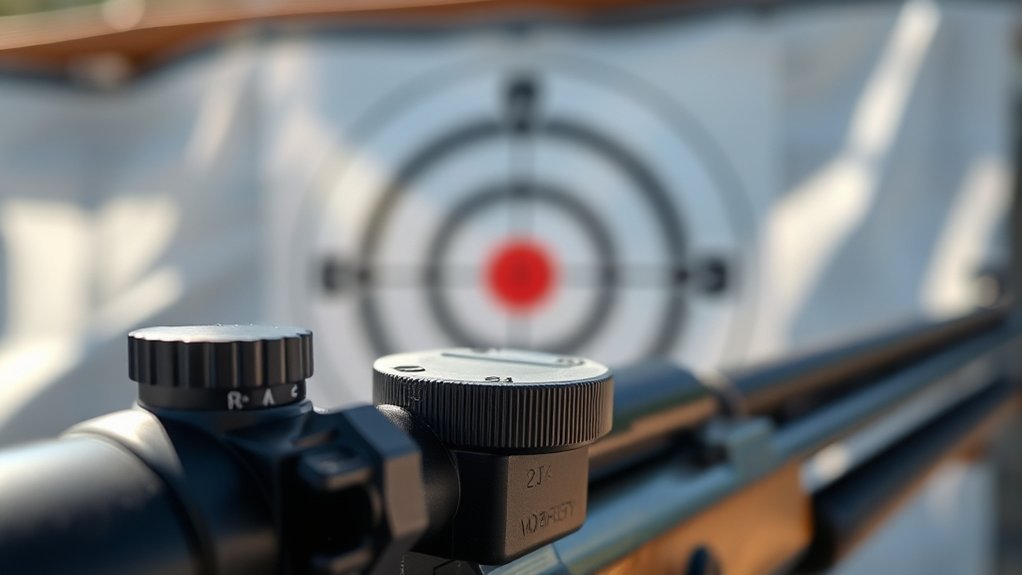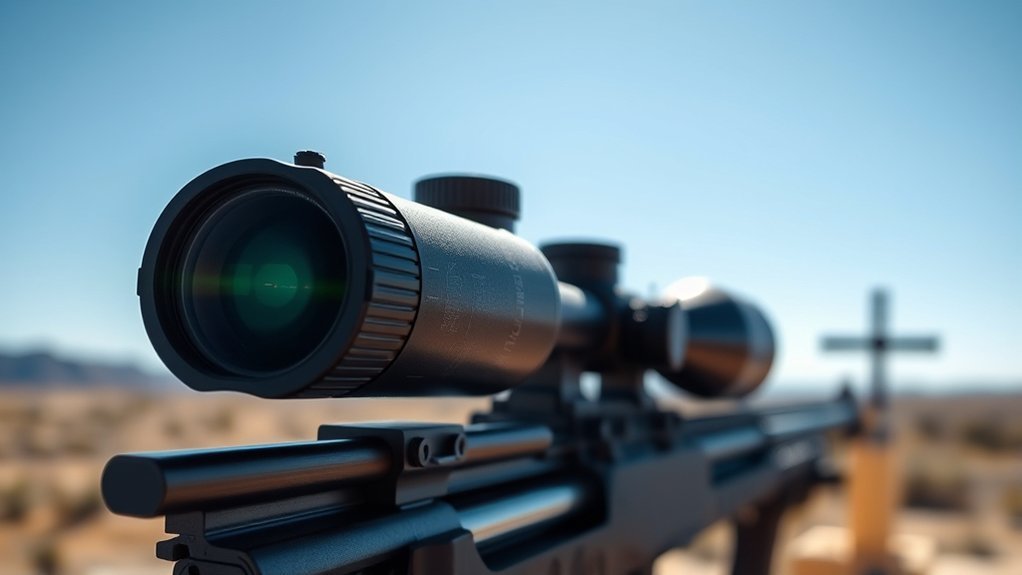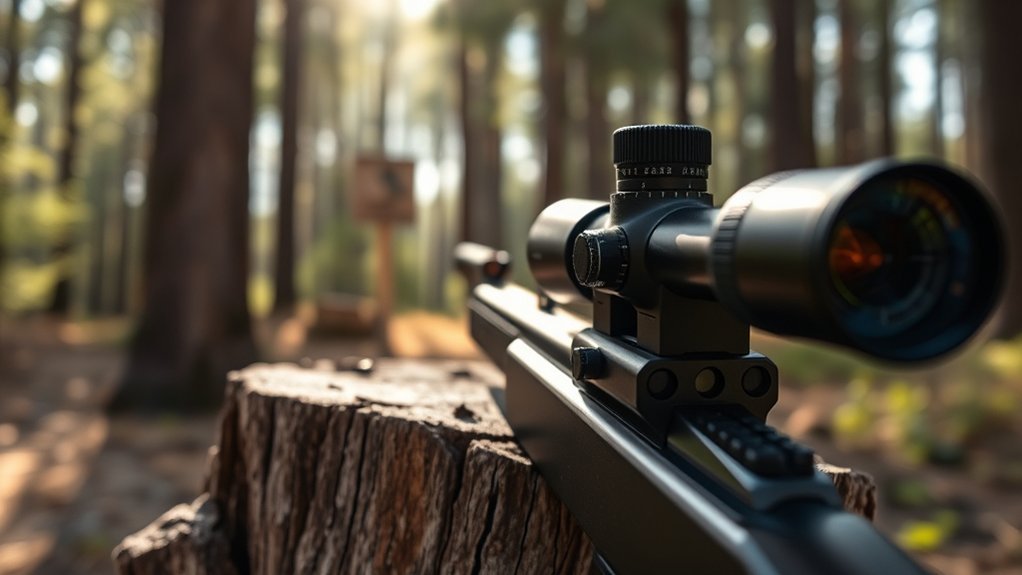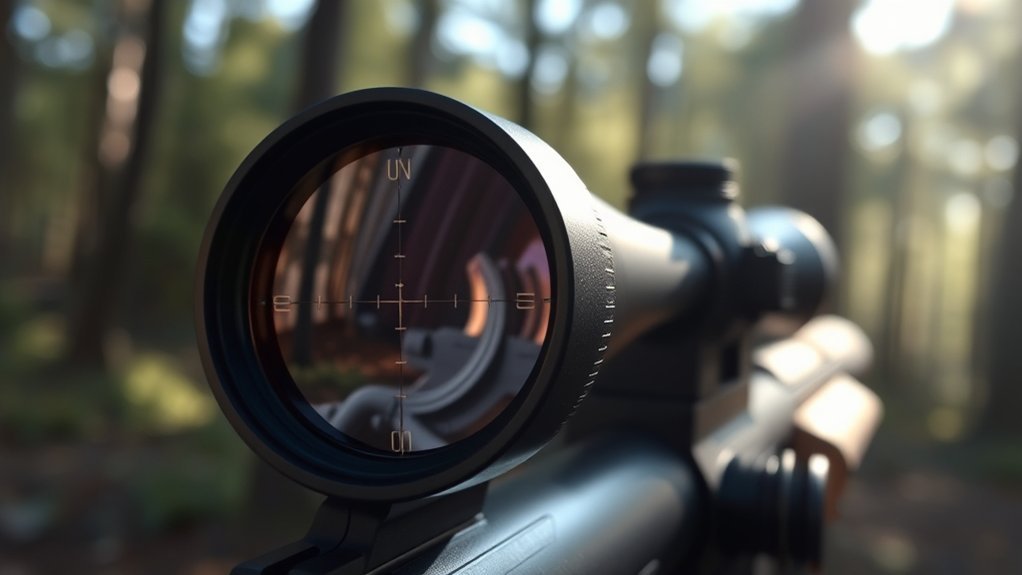Many shooters overlook the impact of parallax in rifle scopes, which can lead to significant aiming errors. When your eye shifts from the ideal position, the reticle may appear misaligned with the target, especially at longer distances. Understanding how parallax affects your shot is essential for improving accuracy. By learning to identify and adjust for these issues, you can enhance your shooting performance and guarantee better alignment with your intended target.
Understanding Parallax: The Basics

When it comes to rifle scopes, understanding parallax is essential for achieving accurate shots. Parallax occurs when the reticle appears to shift relative to the target when you move your head or eye position. This effect can lead to misalignment, especially at varying distances. You’ll notice parallax primarily at longer ranges where the distance between your eye and the scope’s optical axis is more pronounced. Most modern rifle scopes come equipped with parallax adjustment features, allowing you to minimize this effect by aligning the reticle with the target at specific distances. Recognizing the importance of parallax helps you understand how to set your scope correctly, ensuring you maintain precision while aiming, regardless of your shooting position or distance to the target.
How Parallax Affects Accuracy

Parallax occurs when the reticle and the target are not in the same focal plane, causing a misalignment that can lead to inaccurate shots. This misalignment can greatly impact your shooting precision, especially at varying distances. To maintain accuracy, it’s essential to adjust your scope for parallax based on your shooting distance.
Definition of Parallax
Understanding parallax is essential for achieving accuracy in shooting with a rifle scope. Parallax occurs when the reticle and the target don’t align perfectly due to the shooter’s eye position relative to the scope. This misalignment can lead to an apparent shift in the reticle’s position against the target as you move your head. In practical terms, when you’re aiming, if the reticle appears to move away from the target, it indicates parallax error, which can result in inaccurate shots. Most modern scopes come with parallax adjustments to mitigate this issue, allowing you to set the scope’s focus distance to match your shooting range. By understanding and addressing parallax, you can greatly enhance your shooting precision.
Impact on Shooting
While aiming down the scope, even a slight misalignment due to parallax can greatly compromise your accuracy. When the reticle and target appear to shift relative to each other, it can lead to misjudged shots, especially at longer distances. This effect becomes more pronounced if you’re not perfectly aligned behind the scope. If your eye position changes, the image can distort, causing you to miss your intended point of impact. Additionally, parallax error can vary depending on the magnification level; higher magnifications amplify these discrepancies. Understanding how parallax affects your shooting is essential for precision. By being aware of this phenomenon, you can better position yourself and improve your overall shooting performance, ensuring each shot counts.
Adjusting for Parallax
To guarantee accuracy when shooting, you need to adjust for parallax effectively. Parallax occurs when the reticle and the target aren’t aligned due to your eye’s position relative to the scope. If you’re not properly aligned, it can lead to significant aiming errors, especially at longer distances.
To adjust for parallax, first identify the parallax setting on your scope; it’s often measured in yards or meters. Rotate the adjustment knob until the reticle appears to sit perfectly still on the target as you shift your eye. This adjustment makes certain that any movement you make doesn’t affect your point of aim. Regularly checking and adjusting for parallax can dramatically improve your shooting precision, enhancing your overall performance.
The Relationship Between Distance and Parallax

As you increase the distance to your target, the effects of parallax become more pronounced, impacting your aim. Parallax occurs when your line of sight and the optical axis of the scope diverge, causing the reticle to shift relative to the target. At closer ranges, this shift is minimal, but as distance increases, even small deviations can lead to significant misalignment. For instance, if you’re shooting at 300 yards, a parallax error of just a fraction of an inch can translate to several inches off-target. Understanding this relationship helps you recognize the importance of adjusting your scope correctly to the distance of your shot, ensuring precision and accuracy in your shooting. Proper parallax adjustment is essential for maintaining your focus on long-range targets.
Types of Parallax Adjustments in Scopes
When choosing a rifle scope, you need to understand the types of parallax adjustments available. Fixed parallax settings offer simplicity, while adjustable parallax features provide versatility for varying distances. Additionally, a side focus mechanism allows for quick and easy adjustments without altering your shooting position.
Fixed Parallax Settings
While many shooters appreciate the versatility of adjustable parallax settings, fixed parallax scopes offer a straightforward solution for those who prefer simplicity in their optics. These scopes are designed to eliminate parallax error at a specific distance, typically 100 yards, making them ideal for short-range shooting or specific applications. When you use a fixed parallax scope, the reticle remains aligned with the target as long as you maintain the proper eye relief and sight picture. This eliminates the need for adjustments during a session, allowing you to focus solely on your shooting. However, it’s important to remember that fixed parallax scopes may not perform efficiently at distances markedly different from their set range, potentially affecting accuracy in those scenarios.
Adjustable Parallax Features
Adjustable parallax features in rifle scopes provide the flexibility needed for varying shooting distances and conditions. These features typically include a tactile knob or dial that allows you to fine-tune the parallax setting based on the target distance. By adjusting the parallax, you guarantee that the reticle remains on target, regardless of your eye position behind the scope. Common adjustments range from 10 yards to infinity, catering to different shooting applications. Many scopes also indicate distance markings on the parallax adjustment knob, making it easier for you to quickly switch settings. This capability enhances accuracy, particularly for precision shooting, as it minimizes the risk of parallax error at various distances, ultimately improving your shooting performance.
Side Focus Mechanism
A side focus mechanism is one of the most popular types of parallax adjustments found in modern rifle scopes. This system allows you to adjust parallax settings without moving your head, providing greater comfort and flexibility when aiming. You’ll typically find the adjustment knob located on the left or right side of the scope, making it easy to access while maintaining your shooting position. By turning the knob, you can fine-tune the focus for various target distances, effectively eliminating parallax error. This is particularly beneficial in precision shooting, where even slight misalignments can affect accuracy. Understanding and utilizing the side focus mechanism helps you achieve sharper images, ensuring your reticle aligns perfectly with your target at different ranges.
Identifying Parallax Issues While Shooting
Understanding how to identify parallax issues while shooting is essential for achieving accuracy. As you look through your scope, pay attention to the reticle’s movement relative to your target. If the reticle shifts away from the target as you move your head, you’re likely experiencing parallax error. To test this, position your rifle on a stable rest and focus on a fixed target. Move your head slightly up, down, left, and right. If the reticle appears to drift, adjust the parallax setting on your scope until the reticle remains aligned with the target. Always verify your eye relief is consistent; variations can exacerbate parallax problems, leading to missed shots. Recognizing these signs allows you to enhance your shooting precision.
The Importance of Parallax-Free Scopes
Parallax-free scopes eliminate the complications associated with parallax error, greatly enhancing shooting accuracy. When you’re aiming, these scopes guarantee that the reticle remains aligned with your target, regardless of your eye position. This alignment is essential, especially at varying distances, as traditional scopes can lead to discrepancies between where you think you’re aiming and where the bullet actually hits. With a parallax-free design, you can maintain focus on your target without the need for constant adjustments. This reliability boosts your confidence and improves your performance, especially in critical situations. Ultimately, investing in a parallax-free scope allows you to shoot with precision, ensuring that your focus stays on your target rather than worrying about potential errors caused by parallax.
Tips for Minimizing Parallax Errors
To minimize parallax errors effectively, you should start by ensuring that your scope is properly mounted and aligned. Regularly check the focus to match your eye’s position with the reticle. Use the following table as a guide for common practices:
| Tip | Description |
|---|---|
| Proper Eye Relief | Maintain the correct distance from the scope. |
| Reticle Adjustment | Adjust for different distances to eliminate parallax. |
| Consistent Shooting Position | Always use the same stance to reduce variation. |
Additionally, practice shooting at various distances to understand how parallax affects your aim. Familiarity with your equipment will help mitigate errors. By applying these tips, you’ll improve your accuracy and overall shooting performance.
Choosing the Right Scope for Your Needs
How do you know which rifle scope is best suited for your shooting style and needs? Selecting the right scope involves considering several critical factors:
- Magnification: Choose a magnification level that matches your shooting distance. For close-range, lower magnification is ideal, while long-range requires higher levels.
- Objective Lens Diameter: A larger diameter allows more light, improving visibility in low-light conditions.
- Reticle Type: Decide between duplex, mil-dot, or illuminated reticles based on your target acquisition preferences.
- Parallax Adjustment: If you often shoot at varying distances, a scope with adjustable parallax settings will enhance accuracy.
Conclusion
In the world of precision shooting, understanding parallax is like having a compass in uncharted territory; it guides you toward accuracy. By recognizing how parallax affects your aim and addressing it through proper scope adjustments, you guarantee your shots hit the mark every time. Remember, a parallax-free scope is your best ally in this endeavor, allowing you to focus on your target without distractions. Equip yourself with knowledge and the right tools, and watch your shooting performance soar.

